Science
Spacetime ripples reveal black holes gobbling up their neutron star companions – The Weather Network US

Astronomers are reporting an exciting discovery from the depths of the cosmos. Tiny ripples in spacetime have been detected, revealing two separate events where a black hole has swallowed up a neutron star.
A little over five years ago, astronomers announced the very first detection of gravitational waves. These ripples in the very fabric of the universe were the result of two black holes — the most extreme objects in the cosmos — spiralling towards each other and merging in a colossal event.
An artist’s impression of a pair of black holes about to collide to produce an even larger black hole. Credit: Mark Myers, ARC Centre of Excellence for Gravitational Wave Discovery (OzGrav)
Like the aftermath of tossing a pebble in a pond, the merger of these two objects sent ripples radiating outwards through the universe. These ripples were too small to be felt by anyone. Still, they were seen by LIGO — the Laser Interferometer Gravitational-Wave Observatory — which was specifically designed to detect them.
Since that discovery, more gravitational wave detectors have come online, such as the Virgo detector in Italy and the KAGRA detector in Japan. These have led to the discovery of roughly two dozen confirmed mergers and dozens more candidates. Many of the collisions detected have been between black holes. They have also seen mergers between neutron stars.
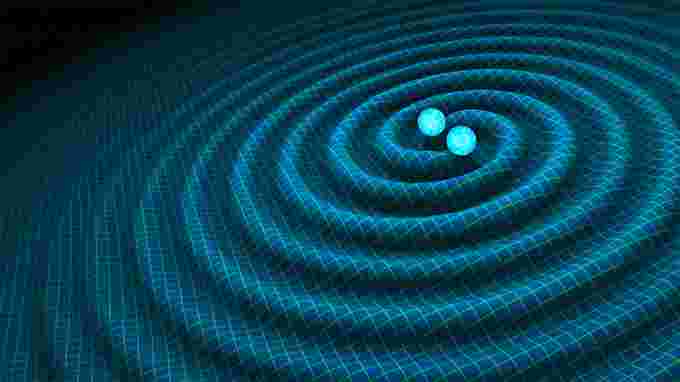

One type of merger that has eluded them so far is between a black hole and a neutron star. There was a possible detection roughly two years ago. Since then, though, it was ruled as more likely a merger between two black holes of different sizes.
Now, an international team of astronomers has made the first confirmed discovery of a black hole-neutron star merger!
Even more remarkable, after years of trying to find just one such merger, the LIGO and Virgo detectors captured two within just 10 days of each other. The first, named GW200105, was spotted on January 5, 2020, where a black hole about nine times the Sun’s mass devoured a neutron star about 1.9 times the Sun’s mass. The second, named GW200115, was seen on January 15, 2020, involving a six-solar-mass black hole and a 1.5-solar-mass neutron star.
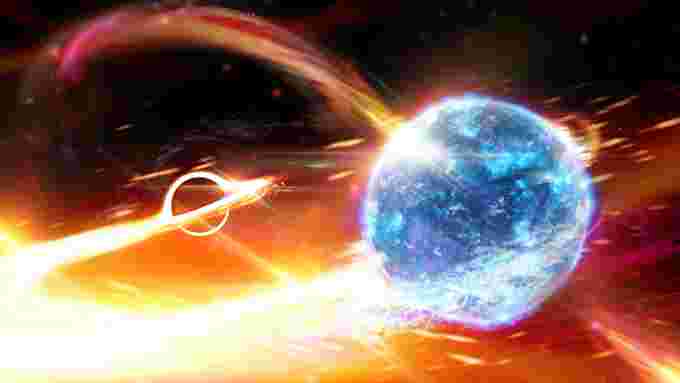

The study that details these two discoveries, which involved around 1,400 scientists from across 285 universities and other research organizations, was published in The Astrophysical Journal Letters on June 29, 2021.
“With this new discovery of neutron star-black hole mergers outside our galaxy, we have found the missing type of binary,” Astrid Lamberts, a co-author of the study from Observatoire de la Côte d’Azur, in Nice, France, said in a LIGO press release on Tuesday. “We can finally begin to understand how many of these systems exist, how often they merge, and why we have not yet seen examples in the Milky Way.”
With different detectors in operation in different parts of the world (LIGO Livingston, LIGO Hanford, Virgo, and KAGRA), if they all pick up one of these events, astronomers have a decent chance of locating where it took place in the universe.
For GW200105, though, only LIGO Livingston and Virgo detected it. Furthermore, only LIGO saw a strong signal for it. Thus, while the researchers could narrow down the distance to around 900 million light years away, they couldn’t pinpoint its location. The best they could do was say it occurred in an area of the sky roughly 34,000 times the size of the Moon.
For GW200115, both LIGO detectors and the Virgo detector picked it up. This allowed the astronomers to narrow it down to an area about 3,000 times the size of the Moon and estimate its distance at around 1 billion light years away from us.
LIKE PAC-MAN, NOT COOKIE MONSTER
When black holes collide, nothing escapes to tip us off. We only detect the ripples through spacetime they produce. However, when neutron stars merge, an explosion of energy and light accompanies it, like the ‘kilonova’ explosion that was detected in 2017.
Watch below: ESO Telescopes Observe ‘Kilonova’ from Gravitational Wave Source
For a black hole devouring a neutron star, however, up until now, there was no telling what we’d see. As it turns out, though, the black holes did not messily tear the neutron stars apart, as a certain blue muppet does with his cookies. Instead, they gobbled up their neutron star companions completely, more like a circular yellow dot-muncher does in his popular video games.
“These were not events where the black holes munched on the neutron stars like the Cookie Monster and flung bits and pieces about,” said co-author Patrick Brady, Spokesperson of the LIGO Scientific Collaboration at the University of Wisconsin-Milwaukee. “That ‘flinging about’ is what would produce light, and we don’t think that happened in these cases.”
“Each collision isn’t just the coming together of two massive and dense objects,” co-author Susan Scott, a Distinguished Professor at Australian National University, said in an ANU press release. “It’s really like Pac-Man, with a black hole swallowing its companion neutron star whole.”
WHAT’S GOING ON HERE?
Stars out in the universe come in many different sizes and colours. At the smaller end, there are red dwarfs and yellow Sun-like stars. At the upper limit, there are blue hypergiants and red supergiants, hundreds to thousands of times the size of our Sun. Many of these stars are alone, but they often come in pairs or even groups.
Every one of these stars has a limited life span. Eventually, they all expend the last of the nuclear fuel in their core and die. Their outer layers are blasted out into space, and they leave behind their core as the final remnant of their existence. When this happens to our Sun, the result will be a white dwarf. This remnant will be roughly the size of the Earth but with nearly all the mass of the Sun.
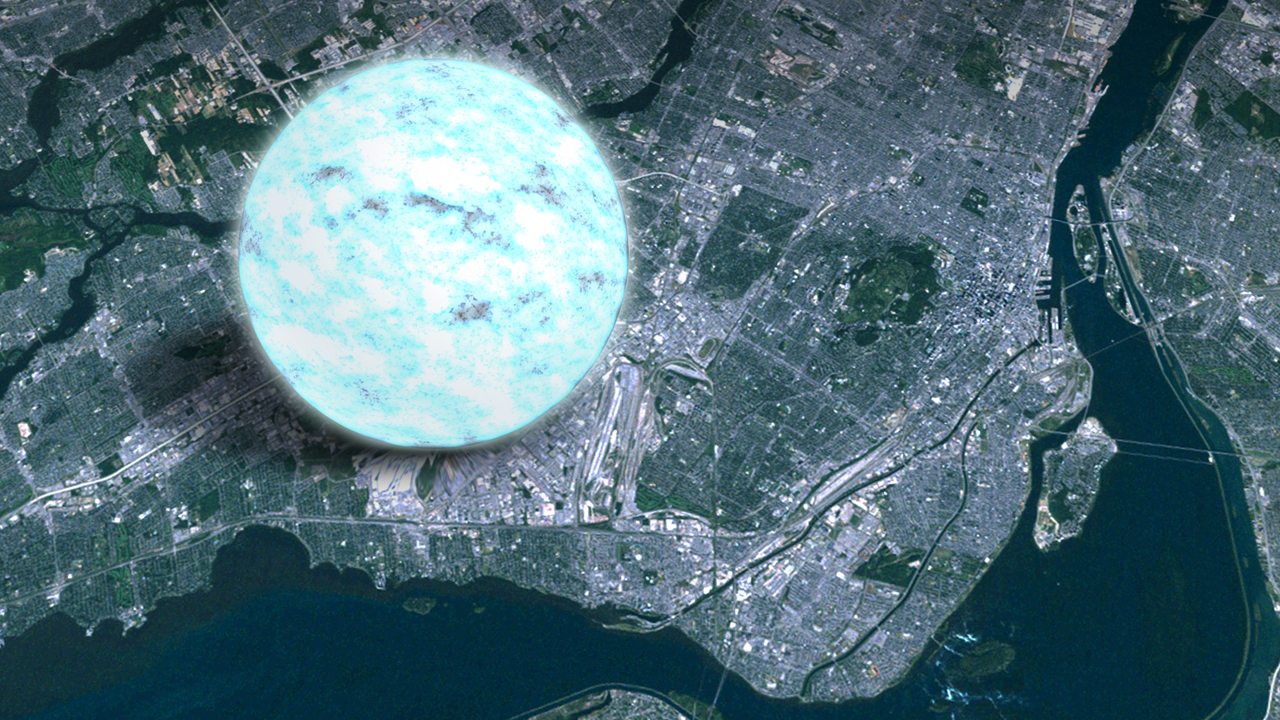

Larger stars have enough mass to crush their cores down almost as far as they can go. In these cases, the leftover remnant is a neutron star — a glowing sphere just 20 kilometres across but packed with more mass than is contained in our Sun.
When the largest stars die, their extreme mass can compress their core past the breaking point of physics. The force of gravity blows past any resistance the matter in the core may muster, collapsing it down to an infinitely small singularity. Surrounding that singularity is a region of space under such extremes that not even light can escape from within it.
Watch below: See the first-ever photo taken of a black hole
When a pair of massive stars have both died and left behind their remnants, the end result can be two neutron stars orbiting each other, or two black holes, or a black hole and a neutron star. This situation isn’t often a stable one, though. The powerful gravitational pull between objects like this causes them to draw closer to one another. They spiral in, getting closer and closer until they eventually collide.
Astrophysicists figured out that if there was such a collision, the titanic forces involved would actually cause the fabric of the universe to warp and ripple. In the moments leading up to the final merger, these ripples would become so extreme that they would radiate outwards from the event, like waves on the surface of a pond. They called these ripples ‘gravitational waves’.
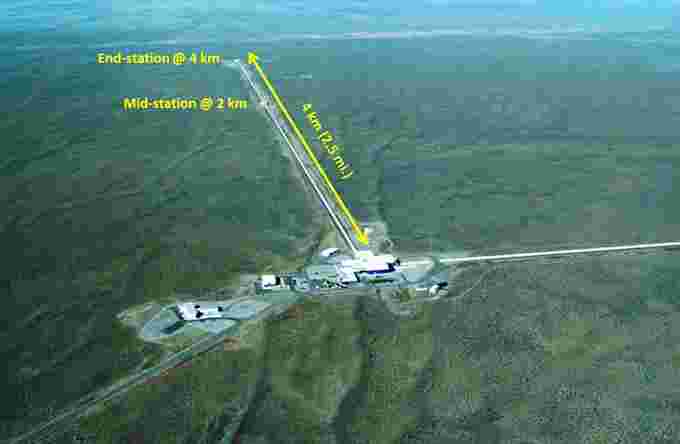

This led to the invention of LIGO, the Laser Interferometer Gravitational-Wave Observatory. This pair of detectors each fire a laser beam down a set of perpendicular 4 km-long tunnels and watch for tiny wiggles in the point the laser makes on the end target. These wiggles can be as small as the width of a single proton, so gravitational wave astronomers rely on very sensitive instruments to spot them.
The first detection of gravitational waves by LIGO, in 2015, earned a group of scientists the 2017 Nobel Prize in Physics. The Virgo detector in Italy came online shortly after that to aid in searching for more gravitational wave events. KAGRA was built in Japan for the same reason.
“The detector groups at LIGO, Virgo, and KAGRA are improving their detectors in preparation for the next observing run scheduled to begin in summer 2022,” Brady said. “With the improved sensitivity, we hope to detect merger waves up to once per day and to better measure the properties of black holes and super-dense matter that makes up neutron stars.”
Science
"Hi, It's Me": NASA's Voyager 1 Phones Home From 15 Billion Miles Away – NDTV


<!–
Launched in 1977, Voyager 1 was mankind’s first spacecraft to enter the interstellar medium
Washington, United States:
NASA’s Voyager 1 probe — the most distant man-made object in the universe — is returning usable information to ground control following months of spouting gibberish, the US space agency announced Monday.
The spaceship stopped sending readable data back to Earth on November 14, 2023, even though controllers could tell it was still receiving their commands.
In March, teams working at NASA’s Jet Propulsion Laboratory discovered that a single malfunctioning chip was to blame, and devised a clever coding fix that worked within the tight memory constraints of its 46-year-old computer system.
window._rrCode = window._rrCode || [];_rrCode.push(function() (function(v,d,o,ai)ai=d.createElement(“script”);ai.defer=true;ai.async=true;ai.src=v.location.protocol+o;d.head.appendChild(ai);)(window, document, “//a.vdo.ai/core/v-ndtv/vdo.ai.js”); );
“Voyager 1 spacecraft is returning usable data about the health and status of its onboard engineering systems,” the agency said.
Hi, it’s me. – V1 https://t.co/jgGFBfxIOe
— NASA Voyager (@NASAVoyager) April 22, 2024
“The next step is to enable the spacecraft to begin returning science data again.”
Launched in 1977, Voyager 1 was mankind’s first spacecraft to enter the interstellar medium, in 2012, and is currently more than 15 billion miles from Earth. Messages sent from Earth take about 22.5 hours to reach the spacecraft.
Its twin, Voyager 2, also left the solar system in 2018.
Both Voyager spacecraft carry “Golden Records” — 12-inch, gold-plated copper disks intended to convey the story of our world to extraterrestrials.
These include a map of our solar system, a piece of uranium that serves as a radioactive clock allowing recipients to date the spaceship’s launch, and symbolic instructions that convey how to play the record.
The contents of the record, selected for NASA by a committee chaired by legendary astronomer Carl Sagan, include encoded images of life on Earth, as well as music and sounds that can be played using an included stylus.
window._rrCode = window._rrCode || [];_rrCode.push(function(){ (function(d,t) var s=d.createElement(t); var s1=d.createElement(t); if (d.getElementById(‘jsw-init’)) return; s.setAttribute(‘id’,’jsw-init’); s.setAttribute(‘src’,’https://www.jiosaavn.com/embed/_s/embed.js?ver=’+Date.now()); s.onload=function()document.getElementById(‘jads’).style.display=’block’;s1.appendChild(d.createTextNode(‘JioSaavnEmbedWidget.init(a:”1″, q:”1″, embed_src:”https://www.jiosaavn.com/embed/playlist/85481065″,”dfp_medium” : “1”,partner_id: “ndtv”);’));d.body.appendChild(s1);; if (document.readyState === ‘complete’) d.body.appendChild(s); else if (document.readyState === ‘loading’) var interval = setInterval(function() if(document.readyState === ‘complete’) d.body.appendChild(s); clearInterval(interval); , 100); else window.onload = function() d.body.appendChild(s); ; )(document,’script’); });
Their power banks are expected to be depleted sometime after 2025. They will then continue to wander the Milky Way, potentially for eternity, in silence.
(Except for the headline, this story has not been edited by NDTV staff and is published from a syndicated feed.)
Science
West Antarctica's ice sheet was smaller thousands of years ago – here's why this matters today – The Conversation
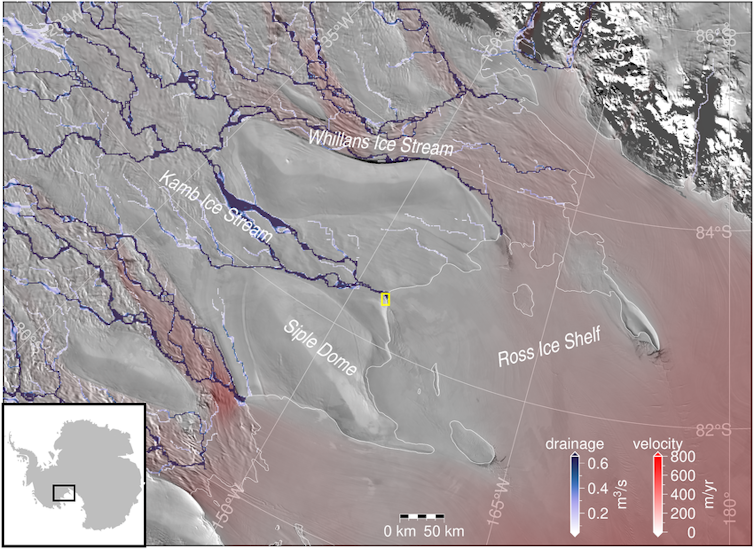

As the climate warms and Antarctica’s glaciers and ice sheets melt, the resulting rise in sea level has the potential to displace hundreds of millions of people around the world by the end of this century.
A key uncertainty in how much and how fast the seas will rise lies in whether currently “stable” parts of the West Antarctic Ice Sheet can become “unstable”.
One such region is West Antarctica’s Siple Coast, where rivers of ice flow off the continent and drain into the ocean.
Journal of Geophysical Research, CC BY-SA
This ice flow is slowed down by the Ross Ice Shelf, a floating mass of ice nearly the size of Spain, which holds back the land-based ice. Compared to other ice shelves in West Antarctica, the Ross Ice Shelf has little melting at its base because the ocean below it is very cold.
Although this region has been stable during the past few decades, recent research suggest this was not always the case. Radiocarbon dating of sediments from beneath the ice sheet tells us that it retreated hundreds of kilometres some 7,000 years ago, and then advanced again to its present position within the last 2,000 years.
Figuring out why this happened can help us better predict how the ice sheet will change in the future. In our new research, we test two main hypotheses.
Read more:
What an ocean hidden under Antarctic ice reveals about our planet’s future climate
Testing scenarios
Scientists have considered two possible explanations for this past ice sheet retreat and advance. The first is related to Earth’s crust below the ice sheet.
As an ice sheet shrinks, the change in ice mass causes the Earth’s crust to slowly uplift in response. At the same time, and counterintuitively, the sea level drops near the ice because of a weakening of the gravitational attraction between the ice sheet and the ocean water.
As the ice sheet thinned and retreated since the last ice age, crustal uplift and the fall in sea level in the region may have re-grounded floating ice, causing ice sheet advance.

AGU, CC BY-SA
The other hypothesis is that the ice sheet behaviour may be due to changes in the ocean. When the surface of the ocean freezes, forming sea ice, it expels salt into the water layers below. This cold briny water is heavier and mixes deep into the ocean, including under the Ross Ice Shelf. This blocks warm ocean currents from melting the ice.
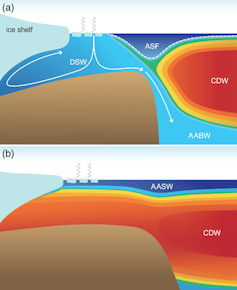
AGU, CC BY-SA
Seafloor sediments and ice cores tell us that this deep mixing was weaker in the past when the ice sheet was retreating. This means that warm ocean currents may have flowed underneath the ice shelf and melted the ice. Mixing increased when the ice sheet was advancing.
We test these two ideas with computer model simulations of ice sheet flow and Earth’s crustal and sea surface responses to changes in the ice sheet with varying ocean temperature.
Because the rate of crustal uplift depends on the viscosity (stickiness) of the underlying mantle, we ran simulations within ranges estimated for West Antarctica. A stickier mantle means slower crustal uplift as the ice sheet thins.
The simulations that best matched geological records had a stickier mantle and a warmer ocean as the ice sheet retreated. In these simulations, the ice sheet retreats more quickly as the ocean warms.
When the ocean cools, the simulated ice sheet readvances to its present-day position. This means that changes in ocean temperature best explain the past ice sheet behaviour, but the rate of crustal uplift also affects how sensitive the ice sheet is to the ocean.

Veronika Meduna, CC BY-SA
What this means for climate policy today
Much attention has been paid to recent studies that show glacial melting may be irreversible in some parts of West Antarctica, such as the Amundsen Sea embayment.
In the context of such studies, policy debates hinge on whether we should focus on adapting to rising seas rather than cutting greenhouse gas emissions. If the ice sheet is already melting, are we too late for mitigation?
Our study suggests it is premature to give up on mitigation.
Global climate models run under high-emissions scenarios show less sea ice formation and deep ocean mixing. This could lead to the same cold-to-warm ocean switch that caused extensive ice sheet retreat thousands of years ago.
For West Antarctica’s Siple Coast, it is better if we prevent this ocean warming from occurring in the first place, which is still possible if we choose a low-emissions future.
Science
NASA's Voyager 1 resumes sending engineering updates to Earth – Phys.org


For the first time since November, NASA’s Voyager 1 spacecraft is returning usable data about the health and status of its onboard engineering systems. The next step is to enable the spacecraft to begin returning science data again. The probe and its twin, Voyager 2, are the only spacecraft to ever fly in interstellar space (the space between stars).
Voyager 1 stopped sending readable science and engineering data back to Earth on Nov. 14, 2023, even though mission controllers could tell the spacecraft was still receiving their commands and otherwise operating normally. In March, the Voyager engineering team at NASA’s Jet Propulsion Laboratory in Southern California confirmed that the issue was tied to one of the spacecraft’s three onboard computers, called the flight data subsystem (FDS). The FDS is responsible for packaging the science and engineering data before it’s sent to Earth.
The team discovered that a single chip responsible for storing a portion of the FDS memory—including some of the FDS computer’s software code—isn’t working. The loss of that code rendered the science and engineering data unusable. Unable to repair the chip, the team decided to place the affected code elsewhere in the FDS memory. But no single location is large enough to hold the section of code in its entirety.
So they devised a plan to divide affected the code into sections and store those sections in different places in the FDS. To make this plan work, they also needed to adjust those code sections to ensure, for example, that they all still function as a whole. Any references to the location of that code in other parts of the FDS memory needed to be updated as well.


The team started by singling out the code responsible for packaging the spacecraft’s engineering data. They sent it to its new location in the FDS memory on April 18. A radio signal takes about 22.5 hours to reach Voyager 1, which is over 15 billion miles (24 billion kilometers) from Earth, and another 22.5 hours for a signal to come back to Earth. When the mission flight team heard back from the spacecraft on April 20, they saw that the modification had worked: For the first time in five months, they have been able to check the health and status of the spacecraft.
During the coming weeks, the team will relocate and adjust the other affected portions of the FDS software. These include the portions that will start returning science data.
Voyager 2 continues to operate normally. Launched over 46 years ago, the twin Voyager spacecraft are the longest-running and most distant spacecraft in history. Before the start of their interstellar exploration, both probes flew by Saturn and Jupiter, and Voyager 2 flew by Uranus and Neptune.
Provided by
NASA
Citation:
NASA’s Voyager 1 resumes sending engineering updates to Earth (2024, April 22)
retrieved 22 April 2024
from https://phys.org/news/2024-04-nasa-voyager-resumes-earth.html
This document is subject to copyright. Apart from any fair dealing for the purpose of private study or research, no
part may be reproduced without the written permission. The content is provided for information purposes only.
-
Business19 hours ago
Honda to build electric vehicles and battery plant in Ontario, sources say – Global News
-



 Science20 hours ago
Science20 hours agoWill We Know if TRAPPIST-1e has Life? – Universe Today
-
Investment23 hours ago
Down 80%, Is Carnival Stock a Once-in-a-Generation Investment Opportunity?
-



 Health17 hours ago
Health17 hours agoSee how chicken farmers are trying to stop the spread of bird flu – Fox 46 Charlotte
-



 Health20 hours ago
Health20 hours agoSimcoe-Muskoka health unit urges residents to get immunized
-



 Investment18 hours ago
Investment18 hours agoOwn a cottage or investment property? Here's how to navigate the new capital gains tax changes – The Globe and Mail
-



 Tech24 hours ago
Tech24 hours agoIndigenous Craft and Vendors Market a success in Halifax
-
News24 hours ago
Can Canada have an effective climate action policy without a carbon tax?






